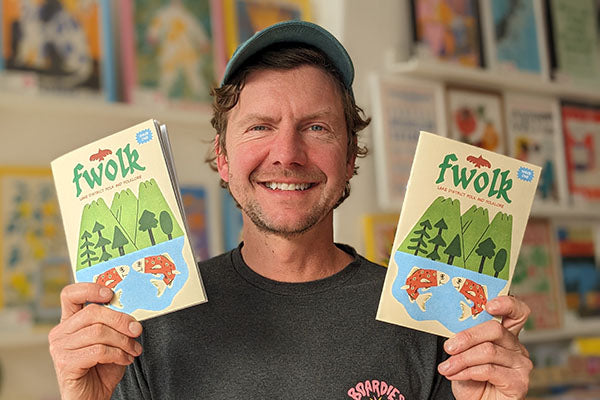
Print Shop Chat with Fwolk founder Jonathan Cowie.
We sat down with Fwolk zine founder Jonathan Cowie to chat about Cumbrian stone circles, prehistoric axe factories and haunted public toilets.
What is the inspiration behind Fwolk?
I wanted to create a zine that celebrates and explores the hidden histories of the Lake District. As a national park and tourist hot spot, there is an “official” history of the Lake District, but there is so much more to the area than Beatrix Potter and Wordsworth. Fwolk is subtitled ‘Folk and Folklore of the Lake District’ and that can mean everything from prehistoric stone circles to modern-day artists or adventurers living in Cumbria. As well as “folk and folklore”, as in traditional culture and history, I also really wanted to celebrate contemporary “folk”, as in people, of the Lake District. Human interest stories are an important part of Fwolk – indeed they are often the root of folklore! Folklore can have this “Ye Olde England” vibe, but modern-day folklore and history is just as interesting.
Every issue of Fwolk will be a jaunt around the Lake District with a mixture of folklore, history, interviews with interesting local people, natural history, magic, megaliths, music and literature, original artwork, photography and ghost stories. Evidently the public toilets in Ambleside are haunted by a poltergeist – that is probably the most fwolk haunting you can imagine!
Where is your favourite place to walk in the Lake District?
I have always loved Langdale but even more so having learnt about the prehistoric axe factory on Pike O’Stickle (read issue one for an interview with archaeologist Steve Dickinson). There are so many layers to the landscape: leisure, agricultural, industrial, sacred – as well as the fact that it is such a stunning place to walk, whether it is a lung-busting run up to Pavey Ark for a dip in Stickle Tarn or a day out hiking all the Langdale Pikes. I haven’t been brave enough to take on Jack’s Rake yet though!
What does "fwolk" mean?
It is Cumbrian dialect for “folk.” I felt it perfectly summed up what I was trying to achieve with Fwolk – folklore and folk in both senses of the word – traditional culture and modern-day people. That human interest element in the zine is really important to me. There is so much contemporary creativity in the Lake District and so many interesting people with stories to share.
Do you have any experience in magazines? What magazines have influenced you?
I have always worked in publishing, so creating a zine has been a bit of a busman’s holiday! I love the creativity and freedom that zines allow – there are so few constraints on content and design. Over the years I have worked in production (producing and designing books and magazines) and editorial (writing and editing) so it has been really enjoyable to create Fwolk and to be able to choose who and what to feature and which artists and writers to collaborate with.
In terms of influence, the first magazine I really loved was Smash Hits when I was a young teenager. We are the Smash Hits of folklore! I also love the human interest stories and top tips of magazines like Take A Break. Hopefully that same irreverence and playfulness is evident in the pages of Fwolk.
How often does Fwolk come out?
It is quarterly-ish. Spring, summer, autumn and winter. So every three months, but sometimes we might be a bit or early or late – just like the seasons! I like the idea of being guided by nature and the seasons.
What can we expect in upcoming issues?
More magic, megaliths and stone circles – Cumbria has the most prehistoric sites of any county. Issue two will be taking a deep dive into the dark side – an issue devoted to the opposite of the mountains the area is famous for: we will be exploring caves, mines, bunkers, the underground dance scene, sunken landscapes, subterranean mer-creatures and a very big pipe.


